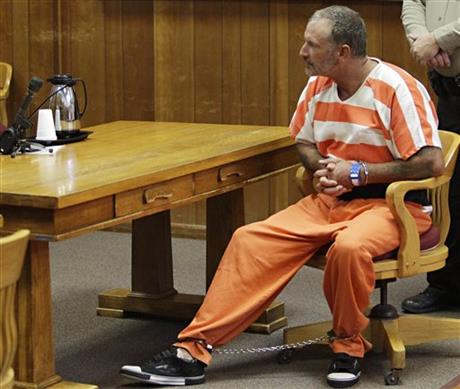FILE – In this Aug. 20, 2013 file photo, former escaped fugitive John McCluskey sits in court for his initial appearance at the Apache County Superior Court in St. Johns, Ariz. attorneys present closing arguments Thursday, Oct, 31, 2013 in the first round of the sentencing phase for McCluskey, who was convicted Oct. 7 of first-degree murder in the August 2010 carjacking killings of Linda and Gary Haas following his escape from an Arizona prison. (AP Photo/Matt York,File)
ALBUQUERQUE, N.M. (AP) — A neurologist testified Thursday that convicted killer John McCluskey used to read The New Yorker and likes to watch the news. Using pencil and paper, he knows how to budget the money he gets each month in prison. His memory is good, and he knows how to follow instructions.
Johns Hopkins neurologist Barry Gordon took the witness stand in the penalty phase of the capital murder case, saying he examined McCluskey two weeks ago for prosecutors.
He told jurors he looked for anything that might affect the convict’s behavior and his ability to make reasoned decisions, taking into account a list of health issues and brain scans.
“I don’t see an effect on behavior from any of those things,” Gordon said. “He has the capacity to control himself.”
McCluskey, 48, was convicted Oct. 7 in the August 2010 carjack killings of Linda and Gary Haas of Oklahoma following his escape from an Arizona prison.
Defense attorneys have been trying to spare McCluskey from the death penalty, arguing that he’s incapable of controlling his impulses or making decisions due to brain abnormalities, emotional and physical abuse, and a long history of drug and alcohol abuse.
Prosecutors called Gordon to rebut such testimony from several defense witnesses.
The witness said there was evidence of a small stroke in the part of McCluskey’s brain best known for controlling coordination, but the effects were unnoticeable and he found nothing else unusual for a man of McCluskey’s age.
Defense attorney Michael Burt questioned claims that McCluskey actually read magazines like The New Yorker or Western Horsema, saying it was the advertisements he liked to look at.
He also grilled Gordon about his testimony in past criminal cases, and whether his evaluation went far enough to determine whether McCluskey had any brain defects.
The same jury that convicted McCluskey will weigh whether he is eligible for the death penalty or a life sentence. Closing arguments in this phase of the trial are expected next week.
McCluskey was serving 15 years for attempted second-degree murder, aggravated assault and discharge of a firearm when he and two other prisoners escaped from a medium-security prison near Kingman, Ariz., in July 2010 with the help of his cousin and fiancee, Casslyn Welch.
One inmate was quickly captured after a shootout with authorities in Colorado, while McCluskey, Welch and inmate Tracy Province headed to New Mexico.
Testimony showed the trio targeted the Haases at a rest stop near the New Mexico-Texas state line.
Province and Welch pleaded guilty last year to charges of carjacking resulting in death, conspiracy, the use of a firearm during a violent crime and other charges. They both said McCluskey was the triggerman.




